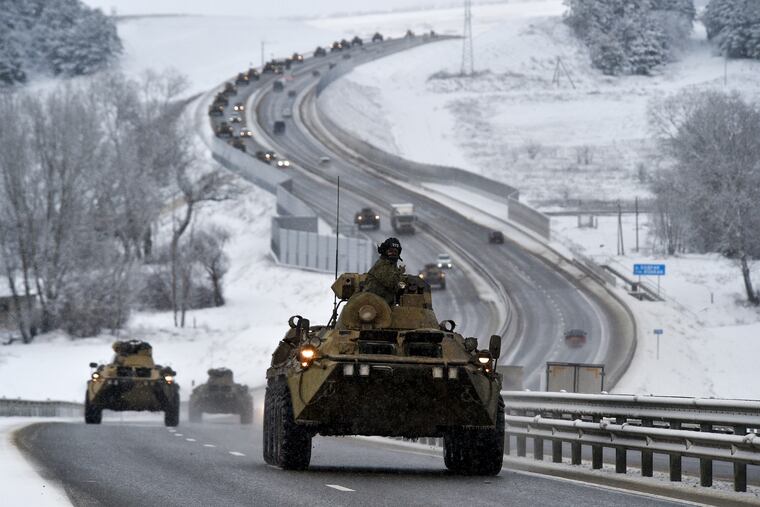Putin may create a fake excuse to invade Ukraine — again | Trudy Rubin
Russia used propaganda and violent provocations to create fake excuses for its first invasion of Ukraine in 2014 and is trying to repeat the process now.

Last week the White House accused Moscow of sending saboteurs into eastern Ukraine to create a provocation that would give Vladimir Putin an excuse to invade the country, after amassing at least 100,000 troops on its borders.
No hard evidence was presented. The assessment was reportedly based on U.S. intercepts and movements of certain individuals. But the accusation reminded me of the provocations Putin used to justify his first invasion of Ukraine, which I saw on a reporting trip in 2014. They involved using pro-Russian agents to terrorize Russian-speaking Ukrainians with the goal of convincing them they must turn to Moscow to protect them.
In other words, Putin was willing to harm those Ukrainians he professed to support in order to convince them to turn against the Ukrainian government. These kinds of provocations worked in the easternmost region of Ukraine, the Donbas. This region is now mostly controlled by Russian proxies who are armed by Moscow and supported by nonuniformed Russian troops.
But many other Russian-speaking Ukrainians — especially, as I learned, in the key city of Odessa — caught on to Russian intelligence tricks; they blocked Putin from expanding the Russian occupation all across southern Ukraine. If Putin tries such trickery now to justify an invasion, he will no longer be able to fool Ukrainians — or the world.
So it is useful to take a look back at 2014 and the way Putin operated when Russia first invaded Ukraine, seizing Crimea and sending proxies from Moscow (some Ukrainian-born but Russian-speaking) to stir up a revolt in the Donbas.
2014: ‘Fascists’ and little green men
Step one involved clever propaganda. You may recall that the soldiers who took Crimea wore no Russian uniforms (and became known as the “little green men”). The Kremlin denied then that it had forces in Crimea and still denies it has troops or proxies in the Donbas.
But then came step two. Russian proxies cut off links to Ukrainian TV in the Donbas, leaving only access to Russian TV. Then, as now, Russian media outlets broadcast hysterical reports about Ukrainian “fascists” who wanted to rape and kill Russian speakers.
Even more grotesque, anti-Semitic desecrations of Jewish cemeteries and synagogues began occurring in several cities. They included the legendary Black Sea port of Odessa, a mostly Russian-speaking city. Russian media and officials played up these incidents to the world as proof that the Ukrainian government was dominated by “fascists.”
So I visited Odessa’s chief rabbi, Avram Wolff, and asked him whether Russia’s claims about Ukrainian “fascists” were correct. “In this conflict, there is no involvement of anti-Semitism,” said the rabbi. “This is strictly between Ukraine and Russia.” Pro-Russian provocateurs, he said, were trying to frighten Jews into asking Russia for help, thus confirming Kremlin propaganda.
When swastikas were sprayed on Jewish gravestones in Odessa, Wolff called a top leader of the small, extreme Right Sector party, who denied it was involved - and sent a militiaman to scrub off the graffiti. Wolff showed me a picture of the militiaman, wearing fatigues with a neofascist shoulder patch, who was cleaning up the graffiti with the bearded rabbi looking on.
But Moscow tried a more violent provocation in Odessa. It hoped to seize the city in order to restore Russian control over all of southeastern Ukraine, a region called Novorossiya during Russia’s imperial era and one that Putin has mused about.
Armed pro-Russian activists penetrated a march of soccer fans in early May 2014. They opening fire, killing two marchers and goading many more to chase the attackers to a square where some pro-Russian supporters were camped. A fire ensued in the building where many from the encampment had taken shelter. Many Odessans believe the fire was started by a pro-Russian provocateur tossing a Molotov through a window. Dozens died.
» READ MORE: Putin wants to reestablish the Russian empire. Can NATO stop him short of war? | Trudy Rubin
Kremlin propaganda blared that fascists had burned Russian speakers alive. Moscow no doubt expected Odessa’s leaders to beg Moscow for aid. This did not happen. Civil society groups in Odessa calmed the situation.
“We did our best to save people from the fire,” I was told at the time by Konstantin Ivanov, a computer engineer with a black belt, who helped organize Odessa self-defense units to calm any violence. “There is a high chance to keep the city stable.” And they did.
2022: Putin’s dangerous games
That doesn’t mean that Russia won’t try again to take over parts of Novorossiya.
Ukrainian military intelligence announced it had intercepted information about a Russian plot to start a military sabotage attack from across Ukraine’s southern border, where Russian troops occupy a disputed area of Moldova. Pro-Russian provocateurs would fire on Russian troops and blame the attack on Ukrainian forces as a justification to invade.
» READ MORE: Don't let U.S. focus on China let NATO get away with invading Ukraine | Trudy Rubin
But during these days, with all eyes on Russian maneuvers, Putin can no longer fool anyone with little green men or attacks on his own soldiers. No matter Kremlin’s denials, the world will see through such maneuvers.
The big question is whether Putin cares. The United States and its NATO allies must convince the Kremlin that the costs of such provocations will be too high for him to risk them, which would require providing Ukraine with critical defensive weapons before a Russian invasion. Right now the Russian leader does not yet seem deterred from his dangerous games.